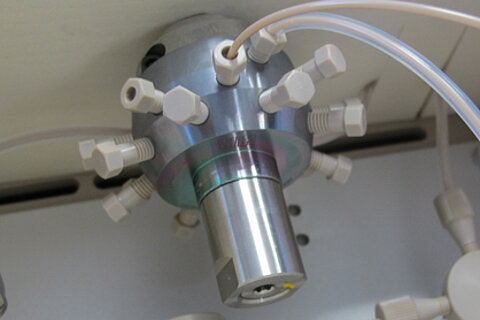IONICON PTR-TOF-MS - Trace VOC Analyzer - PTR-TOF 1000
IONICON PTR-TOF-MS - Trace VOC Analyzer
Sensitivity: > 200 cps/ppbv
Resolution: > 1500
LoD: < 10 pptv
Overview
Enter into the world of PTR-TOFMS with IONICON’s PTR-TOF 1000 and benefit from all the advantages only powerful time of flight based solutions offer:
- the entire mass range in split-seconds - no selection of masses - no waiting
- fast and sensitive for complex VOC mixtures and
- high mass resolution for better separation and identification.
More than a hundred PTR-TOF 1000 installations all over the planet are proof of its popularity and reliability. The PTR-TOF 1000 is the first choice for various international research campaigns but especially for 24/7 industrial monitoring or mobile air quality lab applications. It comes with a fully integrated IONICON data acquisition and data treatment software suite and can optionally be configured as automated VOC monitor with a customized substances identification library.
The PTR-TOF 1000 is our most affordable time PTR-TOF trace gas analyzer. Don't settle for anything less advanced, robust and reliable!
But wait, the PTR-TOF 1000 is just the beginning: expect up to 10x higher sensitivity with the PTR-TOF 1000 ultra.
Technical specifications
| Mass resolution | > 1500 m/Δm (FWHM) for m/z > 79 |
| Response time | < 100 ms |
| Sensitivity | > 200 cps/ppbv for m/z 181 |
| Detection limits | < 10 pptv for m/z 181 (averaged over 1 minute) |
| Linearity range | 10 pptv - 1 ppmv |
| Adjustable flow | 50 - 800 sccm |
Inlet system heating range | 40 - 180°C (2nd inlet system and other inlet options on request) |
| Reaction chamber heating range | 40 - 120°C |
| Weight | < 125 kg |
| Dimensions (w x h x d) | 60x91x80 cm (23.7 x 35.9 x 31.5 in.) |
| Power supply | 115/230 V, standby/typical operation: < 400/500-800 W |
| Interfaces | -Touchscreen display 8x DI/O, 2x AI, 2x AO |
| Responsable | Sr. Marc Gibert |
|---|---|
| Última actualización | 10/02/2025 |
| Tiempo de finalización | 55 minutos |
| Miembros | 1 |

Industrial Applications
Saving you money by monitoring and controlling production processes, emissions and throughput, that's our aim. See some examples of how we do this.
Amine Emission Monitoring in CCS
Monitoring Amine Emissions using the IONICON PTR-TOF analyzer
Industrial Safety
Real-Time Detection of Hazardous Volatile Compounds with Mobile PTR-TOF
Fenceline Monitoring
PTR-TOF real-time air quality monitoring around chemical plants
AMC Clean-Room Monitoring
Monitoring of volatile organic contamination in clean-room environments
Petrochemical Applications
Process monitoring in the petrochemical industry
Automotive
Real-time PTR-MS vehicle exhaust analysis
Biotechnology
On-line monitoring of bioprocesses
Waste Incineration
Monitoring of waste incineration and dioxin emissions
Industrial VOC Monitoring
Reliable automated industrial VOC monitoring

What does the abbreviation "PTR-MS" stand for?
PTR-MS is the abbreviation for Proton Transfer Reaction - Mass Spectrometry, allowing for real-time measurement of volatile organic compounds (VOCs) at even very low concentrations. Originally developed by scientists at the Institut für Ionenphysik at the University of Innsbruck, Austria and the founders of our company, this technology has been commercialized by IONICON Analytik.
How does PTR-MS ionize the substances?
In a drift tube protonated water (H3O+) interacts with molecules that possess a higher proton affinity than water. This means that one proton switches from H3O+ to the molecule (M) and therefore produces MH+.
How is mass separation of the ions done?
Customers may choose between a quadrupole mass filter in PTR-QMS series and a time-of-flight mass analyzer in PTR-TOFMS series systems. Compare advantages of quadrupole and time of flight here. Time of flight mass spectrometers due to their high mass resolving power can separate between isobars, hence allow for identification of compounds which have the same nominal mass. The Selective Reagent Ionization – Mass Spectrometry (SRI-MS) technology allows for identification of even some isomers. With the fastGC add-on IONICON instruments now have GC capabilities - chemical separation in combination with real-time measurements. Unique to PTR-MS – and a major advantage over e.g. SIFT-MS – is the capability to change the energy levels in the drift tube, which suppresses or increases fragmentation. Distinct fragmentation patters that are observed by varying this energy levels (E/N) foster the identification capabilities of IONICON PTR-MS further. This method is used in our air monitoring solutions.
What are the advantages of PTR-MS compared to conventional mass spectrometry?
PTR is a soft chemical ionization process, which means that in contrast to electron impact or charge transfer ionization the fragmentation rates can be kept very low. Therefore, absolute concentrations can be derived immediately. In addition, common compounds of ambient air do not get ionized, which makes mass spectra easily interpretable and accounts for very low online detection limits in the pptv-range. Learn more…
What are the advantages of PTR-MS compared to SIFT-MS?
Unlike SIFT-MS, PTR-MS does not dilute low concentrated samples by any carrier gas and lose precursor ions to the mass filter between the source and the drift tube, hence PTR-MS is much more sensitive, has a lower detection limit and does not need any gas supply (proton transfer from H3O+ ions). Our instruments are light-weight (i.e. the portable PTR-QMS 300 weights only 70 Kg) and space-saving which clearly puts us ahead of technologies like SIFT-MS. Moreover, only PTR-MS is available in a range of time-of-flight (TOF) based PTR-TOF instruments which has a lot of advantages. Last but not least, unlike with SIFT-MS, energy levels (E/N) in the drift tube can be varied in PTR-MS, catering to better identification capabilities. PTR-MS and SIFT share a common history. Learn more about the evolution from SIFT to PTR-TOF which resulted in ultimate performance and technological perfection.
What are the advantages of PTR-MS compared to gas chromatography?
With PTR-MS, substances do not need any pretreatment and can be measured online, in real-time over a range of six orders of magnitude down to a minimum concentration of less than 1 pptv (depending on the model). Even relatively fast GC-MS systems work with much longer time spans and are therefore considered as an "offline" method. Learn more...
What are the advantages of PTR-MS compared to SIFT-MS?
Unlike SIFT-MS, PTR-MS does not dilute low concentrated samples by any carrier gas and lose precursor ions to the mass filter between the source and the drift tube, hence PTR-MS is much more sensitive, has a lower detection limit and does not need any gas supply (proton transfer from H3O+ ions). Our instruments are light-weight (i.e. the portable PTR-QMS 300 weights only 70 Kg) and space-saving which clearly puts us ahead of technologies like SIFT-MS. Moreover, only PTR-MS is available in a range of time-of-flight (TOF) based PTR-TOF instruments which has a lot of advantages. Last but not least, unlike with SIFT-MS, energy levels (E/N) in the drift tube can be varied in PTR-MS, catering to better identification capabilities. PTR-MS and SIFT share a common history. Learn more about the evolution from SIFT to PTR-TOF which resulted in ultimate performance and technological perfection.
How does PTR-MS compare to SIFT-MS, APCI, MS-e-noses, other CIMS and related direct injection mass spectrometry methods?
PTR-MS is generally much more sensitive than SIFT-MS (according to the authors around two orders of magnitude). The “downside” of PTR-MS, providing only one type of precursor ions (H3O+, the most important type though) has been overcome by a technology we call Selective Reagent Ionization - Mass Spectrometry (SRI-MS), where H3O+, NO+ and O2+ can be produced in the IONICON ion source with even higher yields than SIFT-MS. Also the possibility to use several energy levels (E/N) in the drift tube is not possible with SIFT-MS, but this feature enhances the unique substance identification capabilities of PTR-MS significantly. Compared to APCI, a widely used technology, PTR-MS allows for more accurate quantification due to a controlled and very efficient ionization, offering higher sensitivity. Compared to many other CIMS, IONICON PTR-MS has a well controlled and straightforward ionization process which results in 4 important ion-chemistry qualities only available from IONICON. Moreover, the new EVR PTR-MS technology offers the fastest response time in the CIMS market. PTR-MS is extremely versatile, used in various applications and is commercially available as IONICON’s product portfolio: ultra-sensitive quadrupole or high-resolution time-of-flight based systems.
Other manufacturer's systems are sometimes also called "PTR-MS", what's the difference to a real IONICON PTR-MS?
PTR-MS has been invented by the founders of our company and now more than 20 years later, is more popular than ever before. Sometimes other instrument manufacturers call their system "PTR-MS" or "H3O+ CIMS" etc. if they use proton transfer by H3O+ as their primary ionization technique. But there's much more to an IONICON PTR-MS. A real PTR-MS is characterized by 4 important ion-chemistry quality dimensions which enable quantitative real-time results and are only available from IONICON. Learn more about the essentials of an IONICON-grade PTR-MS.

Industrial VOC Monitoring
We offer customized and automated air monitoring solutions for reliable industrial process VOC monitoring.
Benefits of IONICON monitoring systems
We combine the advantages of our technology with an easy-to-use interface and an automated system software in order to create robust automated VOC analyzers for industrial production sites.
Low cost per sampling point
Due to our very low detection limits (< 1 pptv) and our ultra fast sampling and detection system (response time < 100 ms) we are able to monitor different sampling points with one instrument in a very advantageous time per measurement cycle.
Modular software
Our in-house software department develops software solutions according to your individual monitoring needs. We have a modular system software that fulfils your requirements in terms of identified substances, measurement cycles, sampling points, alarm settings and triggered actions. One-button operation using a touchscreen display and data interfaces facilitate the integration into existing monitoring networks. We call this AME: Automated Measurement and Evaluation.
Scalable solution
Our inlet solutions are based on our customers’ requirements for sampling points, sample line lengths and the desired sampling frequency. Therefore we can provide a wide range of solutions for small to very large plants and for one or for many sampling points/lines.
Custom multiplexing inlets
The IONICON engineering department has experience in designing customized multiplexing solutions based on your needs. Different valve and layout options are available depending on the number of sampling ports, the gases to analyze, length of lines and other criteria. We can create an integrated solution for your application.
User-friendly
Our instruments are software controlled in order to auto-check their performance and built-in calibration for the specific monitoring task. The user interface is operator friendly and displays a clear overview of necessary information to keep workplaces and your plant safe.
Optimized for fast maintenance
Our technology does not need any expensive gases, water flow or compressed air to work and our engineering focuses on accessibility of critical parts. Thus the operational costs and maintenance needs are low compared to other systems. A structured service plan with distinct maintenance intervals allows our customers to calculate operational costs.
Case Study: AMC-Monitor
A prominent example of an IONICON solution for automated trace gas monitoring is the semiconductor industry. We developed a fully integrated system for detection of airborne molecular contamination (AMC) in cleanrooms and processes of wafer production, handling and transport.
Multiplexing
Multiple Inlet Systems for Analytical Instruments
Multiport sampling devices, based on multiplexing valves or custom built gas-stream selectors allow for sampling at different location and bring down your cost per sampling point.

Multiplexing valves
We offer a variety of valves for splitting the available inlet ports of your system in two or three (e.g. two-way, three-way valves made of PTFE or PEEK). You can also increase available inlet ports by multiplexing valves providing 12, 16, 18 ports or more. Such valves are a very cost-effective and proven way to multiply the locations you can sample many times. We have tested these valves and offer them integrated into the inlet system of your PTR-MS! All you need to do is go on sampling!
Custom built gas-stream selectors
We are a solution based technical engineering company and even complex systems of sampling set-ups, gas stream-selectors or valve-arrays can be offered to you. We can even take care of calibration and zero-gas/filtration options and provide the right lines and necessary pumps for your measurement task. It's all about catching the sample right at the spot and having it introduced into your analytical instrument asap without losing too much of your sample to wrong-chosen material of your sampling lines. Think about it...or speak with us
Optional. Integrated Calibration Device
Use a port of your multiport valve for calibration
This built-in calibration system dynamically dilutes VOC gas standards with VOC free air (zero air) to measure calibration factors, linearity, background and LODs. With the internal multiport-valve, measurements can be fully automated.
The internal calibration system was made to make regular calibrations of our PTR-MS instruments easier and more effective. Let us summarize some quick facts about the internal calibration system.
- Catalyzer and Flow controller (up to 400 sccm) for generation of zero air
- passivated Flow controller up to 50 sccm (20 or 100 sccm optional available) for calibration gas (gas tank and pressure reducer NOT included!)
- Dilution ratio: 1:400 to undiluted
- Multiport valve allows automated switching to calibration system
- Automated calibration measurements
- Automated background measurement
Attention: The multiport valve is mandatory for using the internal calibration system!